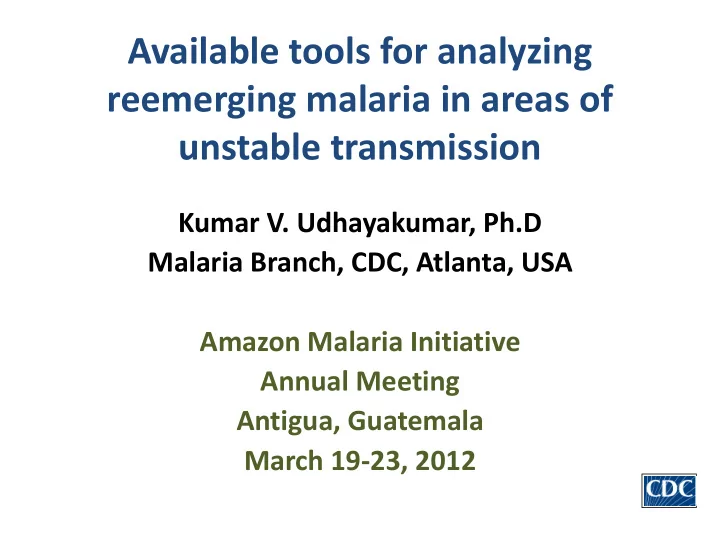

Available tools for analyzing reemerging malaria in areas of unstable transmission Kumar V. Udhayakumar, Ph.D Malaria Branch, CDC, Atlanta, USA Amazon Malaria Initiative Annual Meeting Antigua, Guatemala March 19-23, 2012
What we want to learn? Where did the parasite come from? Is it a single or multiple independent introductions? What is the genetic background of drug resistance? Can we find any other information relevant for informing a public health response?
Integrating laboratory tools in epidemiologic investigations Involve lab scientists to the investigative team Importance of collecting good specimens for lab investigations from the beginning Blood specimens for microscopy and storage of blood in filter paper or frozen blood (systematic approach) Confirm the local microscopic diagnosis with national reference labs (Quality control) Use molecular tools for confirming species identification and determining origins of parasite population
Molecular Tools Is it related to older populations from the area? Other Genetic analysis of parts of Border reemerged malaria the countries? parasites world? Is it related to other areas Database in the host country? of parasite genotypes
Concepts of using molecular tools Different clonal Neutral Related to populations in Peru microsatellite which markers population ? Central America (CVMNK) Drug South America (Amazon) Which (SVMNT) resistance region? markers South America (West/Coast) Eg: pfcrt (CVMNT) Africa/SE Asia Further Other (CVIET) refining of markers locations
Use of molecular tools for investigation of resurgent malaria in Peru • P. falciparum was nearly eliminated for a decade on the Peruvian coast • Reappeared in 2010-continues.. • Investigation and analysis
Methods • 20 filter paper samples from INS, Peru • DNA isolation and PCR for species • Microsatellite markers (random repeats of 2- 6 bp of nucleotides scattered in the genome) • Eg: ATATATATATATAT
Methods (cont.) • Chose 7 neutral markers for analyzing population structure-PCR and analysis in a sequencer • Previous studies indicated clonal populations (eg: coast had single clonal lineage-E) • Drug resistant markers (pfcrt, dhfr, dhps)- sequencing • Previous studies have shown distinct drug resistant genotypes in Peru
Clonal lineages in Peru (1999-2000) PC UL A (23) C (1) B (3) D (23) C (28) D (5) CC A (7) B(19) E D(14) (38) PH C (4) E (4) Clonal lineages C, D & E Clonal lineages A and B CQ rest but SP sensitive CQ and SP resistant Griffing S et al., PLoS One, 2011
Microsatellites identified a single clonal population • 18/18 samples showed an identical microsatellite marker pattern (clonal lineage called B/PR) • 2 samples did not amplify Ch6 Ch4 Ch12 Ch6 Ch10 Ch2 Ch3 TA1 Polya PfPK2 TA109 2490 172 182 172 163 83 232 134
Peruvian Amazon has a similar clonal population (2009-2010) Caballacocha B/PR 1/1 Requena B/PR 100% Yurimaguas (12) B/PR 1/12
CQ and SP resistant lineage • CQ resistant pfcrt genotype SVMNT • Sulphadoxine resistant 437G,540E,581G • Pyrimethamine resistant 50R,51I,108N • This genotype is different from common genotype 51I,108N,164L found in Peru • Documented the introduction of this new genotype in Peru in 2006 (Bacon et al 2006)
Another surprise • All the isolates found in Requena had the HRP2 gene (RDTs detect HRP2) deletion • We hypothesized reemergent population in the coast may have HRP2 deletion • Testing showed deletion of HRP2 in all 18 isolates from Tumbes
Conclusions • All the 18 samples (2 did not amplify) we tested have come from a single clonal lineage and likely a single introduction. • These clonal populations are identical to a population found in at least 3 sites in Loretta (may be a source population) • They are CQ and SP resistant and have deleted the HRP2 gene (AS+SP treatment may not be suitable and HRP2 rapid tests will not work).
Conclusions (cont.) • Molecular tools are useful in the investigation of malaria reemergence • Continued collection of molecular data especially in populations targeted for elimination will be crucial for future surveillance and investigation of reemergence • AMI efforts to collect molecular data has helped to answer important questions
Acknowledgements • MOH/INS Peru/Tumbes • Romel V, Gonzales Seminario,Gino F. Garavito C. • Virginia Cruz. • Nancy Arrospide and Sonia Gutierrez • Jaime Chang • Dionicia Gamboa (University of Cayetano Peru) • NAMRU, Peru • Alex Macedo, Sheila Akinyi, Amanda Poe, Joseph Abdallah, Mara Karell, John Barnwell • USAID and PAHO
¡Gracias!
Peruvian Amazon has a similar clonal population
Recommend
More recommend